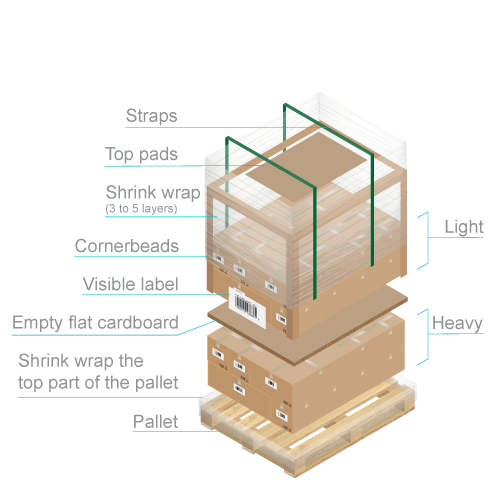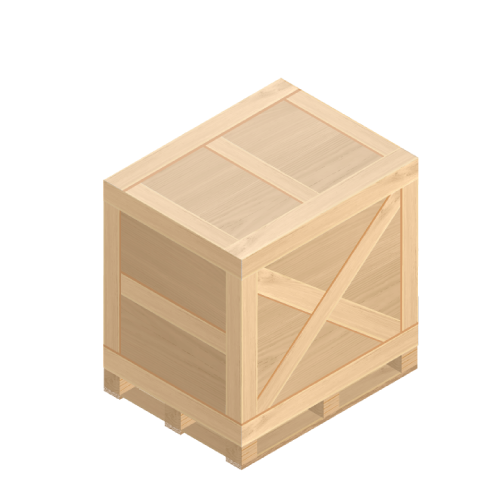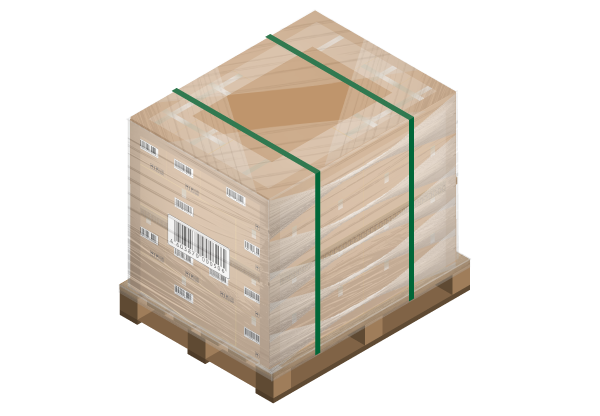Packaging is a major part of the shipping process. Proper packaging is the best way to save yourself from potential cargo damage.
There are many ways to package your shipment and not all of them are created equal. Here are some of the best practices when it comes to packaging freight.
Palletize your shipment
The most common and most cost-effective way of packaging freight is to palletize your shipment.

A pallet is a flat structure used for shipping freight. Most often, pallets are made of wood, plastic, or metal. A pallet is specifically designed to accommodate forklift use and to be easily lifted up and moved by them.
Pallets are relatively easy to make, cheap as far as packaging is concerned, and reliable. As long as your shipment is properly packaged and is not protruding from the pallet, the pallet itself provides ample protection.
As pallets slightly shift inside a truck during transit, pallets are the first point of contact with any other surface as long as the cargo is not too top-heavy.
This takes us to the topic of properly placing your shipment onto a pallet itself. As mentioned, you should make sure that the cargo is not top-heavy to avoid tipping and to make sure your pallet is as maneuverable as possible.
Next, you should place each of the items being shipped into specific boxes for maximum protection. Place each box as close as can be to the next to ensure that there is as little shifting on the pallet itself as possible.
Next, use cardboard corner beads around the pallet to strengthen the whole pallet. You will want to use cardboard between every couple of rows of items as well. This way you are protecting the lower parts of your shipment from the shipment’s own weight.
Finally, you should wrap everything with 3-5 layers of shrink wrap, although even more won’t hurt as long as you don’t overdo it. Once that is complete you are ready to ship. It doesn’t hurt to strap your shipment to the pallet with a nylon strap.
With everything double or triple-wrapped, you have minimized the chances of any potential damage to your shipment and you’re good to go.
Crate your shipment
The more expensive, but by far the safest option is to have your shipment crated. In fact, carriers will straight up refuse to ship some cargo that is considered fragile (such as art) if it’s not in a crate.

Crates provide the highest level of protection possible when it comes to packaging your shipment.
Most commonly, crates are made from plywood, solid wood, and in some cases — plastic or even reinforced with steel.
Depending on the amount of safety you need, plywood crates come in various thicknesses. Starting at quarter-inch thick plywood and going up to three-quarters of an inch thick, plywood can provide ample protection depending on your needs.
For higher-end cargo consider higher-end crates. Compared to solid wood planks, plywood is more porous. That is why there are solid wooden crates out there, usually with metal hinges on the edges for extra safety.
Lastly, if you’re shipping original Rembrandt’s consider the safest option out there — the steel-reinforced crates offering you the ultimate protection.
Of course, it’s not enough to simply purchase a crate and place your cargo in it. Crates are solid and cargo can shift inside a truck during transit. This can lead to your shipment getting damaged anyway.
To avoid this, make sure to purchase a crate that’s the right size for the item you’re shipping. That means that it’s not a super-tight fit, but that it’s not too loose either.
You want just enough room so that you can put padding inside the crate as well. This way, you’re sure that something is absorbing any potential impact your shipment may encounter.
In an ideal situation, your shipment will be padded in such a way that it cannot move at all inside the crate.
Ship it as a piece
Obviously, you are always shipping a piece (of something) one way or another. However, as opposed to shipping a crate or a pallet, shipping a piece is a term used for shipping unpackaged goods.
In our experience, we’ve had clients ship anything from cabinets to car bumpers as unpackaged pieces.
What all our “piece” shipments have in common is that they are light and not high in value. If a shipment is not on a pallet it is much more difficult to maneuver so it needs to be light to be easily loaded and unloaded.
The reason the shipment has to be low in value is that the carrier will simply refuse to pick up anything that seems valuable and is not properly packaged due to insurance and liability issues.
In short, if you’re looking to ship something unpalletized or uncrated, make sure beforehand that the carrier will accept it, and that you won’t feel too bad if it gets damaged. Remember, the packaging is there for a reason and it will always be safer to palletize or crate your cargo.


